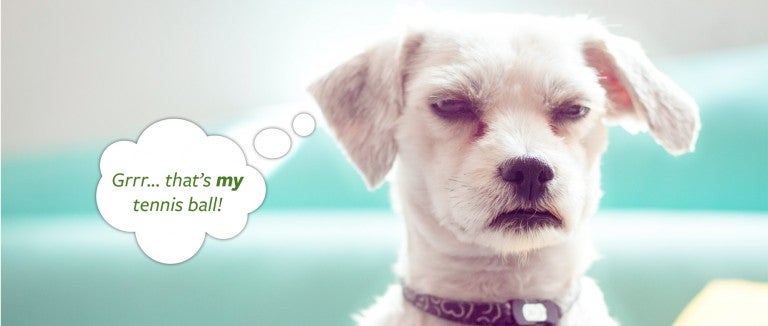What is resource guarding?
If you’ve ever watched as your pup stands rigid over their favorite toy, staring down any other dog who comes close, you might’ve witnessed resource guarding. The term describes a behavior where a dog attempts to assert their ownership over something: toys, beds, treats, a shared water bowl, even a favorite human. (When food is the source of contention, the behavior is sometimes called “food aggression” instead.)
What causes resource guarding or food aggression?
The psychology behind resource guarding varies, but it’s typically based in anxiety. For example, former street dogs often guard food because they’ve gone through a period where they had to forage for every meal. That drive to protect resources can continue even when the dog is in a new home with a secure food source.
Training can also be to blame. In a misguided bid to assert dominance, some owners take a puppy’s food or toy away just as the dog settles in to enjoy it. The result? A dog who thinks that a human approaching the food bowl mid-meal (or the squeaky toy mid-squeak) means the food or the toy will disappear—and will respond defensively.
Although the behavior often occurs with adult dogs, resource guarding in puppies can happen as young dogs learn to navigate their world.
How to recognize resource guarding
Because resource guarding can escalate to more aggressive behavior—including air snaps or even bites—it’s crucial to learn the signs so you can intervene. Watch for cues that your dog is anxious around food, toys, beds or even you or another human family member. Signs of resource guarding can include:
- Growling
- Ears pointed backward
- Lip-licking
- A sudden and obvious stiffness in the body
- Hyper-fixation on an object, dog or human
- Increased attentiveness to other dogs
In general, look for signs that your pup is becoming hyper-aware of another dog’s presence. For example, if one dog stares fixedly at the other during dinnertime and doesn’t look away, they might be worried that they're going to make a move for their meal.
Sign up to receive our exclusive e-book full of important information about caring for your pet, including training techniques and answers to frequently asked questions.

How to stop food aggression in dogs and how to prevent resource guarding
Because perceived scarcity is often at the root of a possessive pup’s behavior, consistently providing ample resources is a good first step. Try these approaches:
- Always provide sufficient and equitable resources. To avoid resource guarding between dogs, make sure you have enough toys, beds, treats and food to go around. For example, if you adopt a second dog and buy them a new bed, your first dog will probably want to hang out on the fluffy new bed.
- Use positive reinforcement to encourage good behavior. Try dropping tasty treats into the bowl while your pup is eating—that way, they’ll associate a human walking up to their bowl with something good happening. If you struggle with training yourself, you can consider searching for a qualified dog trainer.
- Similarly, if they're defensive toward other dogs, try to make dinnertime a positive experience. If they mind their own business and don’t growl at their companion, offer treats.
- Teach “give” and “leave it” cues by pairing the action (the dog giving something up) with a reward (a treat)—and always offer a trade if you need to take something away.
Remember that there’s no quick fix: It might take a while for your dog to realize that they don’t have to protect their belongings. In the meantime, try these interventions to ensure resource guarding doesn’t escalate:
- Remove problem items. If your dog is possessive when it comes to a specific toy, just take it out of the house.
- Sequester dogs in different rooms during mealtimes to prevent food aggression.
- Consistently reward good behavior and never punish dogs for “bad” behavior. For example, if there are squabbles at bedtime, assign each dog a bed and train them to go there on cue, rewarding each successful action with a treat. If they go in the wrong bed? No treat.
- Work to build your dog’s confidence. Expose them to new situations, people and animals (safely, of course) and reward them when they do well.
Be especially alert in new situations, which can bring out these tendencies. For example, if a new dog visits, create a neutral environment free of items that might cause tension. Put the toy basket away, close the crate and don’t leave the food bowl out.
Stay vigilant in other places, too. Don’t bring toys to the dog park, and if you take your pup to doggie daycare, ask the staff to tell you if they notice any guarding behavior.
When to seek professional help for resource guarding
If you’ve tried all the steps above—providing ample resources, removing toys that cause tension, working on positive reinforcement training—and the behavior hasn’t changed, it could be time to seek professional help. (Some dogs will simply begin resource guarding another item or even another person, so watch for those changes.)
Your veterinarian can recommend a trainer or behaviorist who will work with you more rigorously. (Be sure to choose a professional who uses positive reinforcement only.) And if you’re not sure you've reached that point, try this simple metric: If you’re worried your dog might bite someone, that’s a good sign you need to call in the experts.
